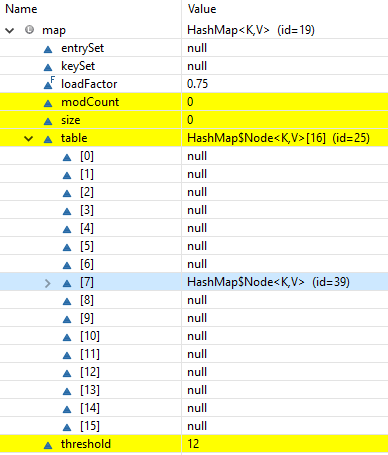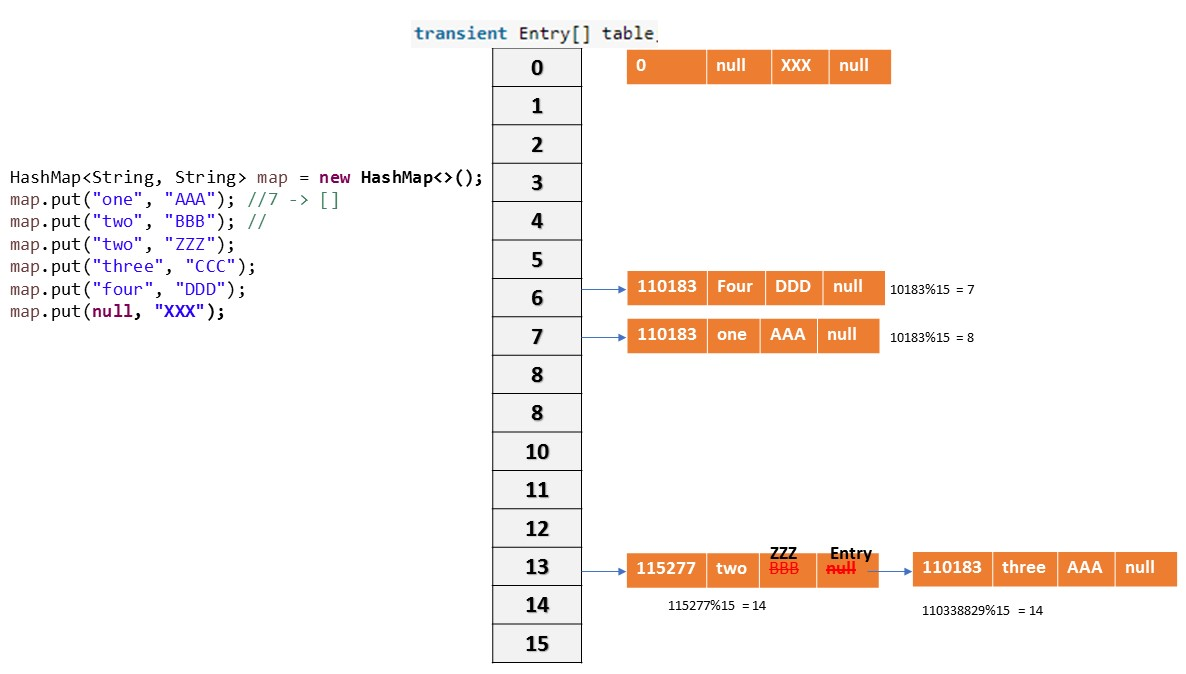HashMap – Internal implementation (HashTable)
-
The underlying datastructure is Hashtable+LinkedList
-
Insertion order is not preserved & it is based on **Hashcode of
** -
Duplicate keys are NOT allowed, but values can be duplicated.
-
Heterogeneous objects are allowed for both Key & Value
-
null is allowed for key (only once)
-
null is allowed for Values (any no. of times)
-
HashMap implements Serializable & Clonable interfaces but not RandomAccess
-
HashMap is the best choice for Searching operations
Constructors
-
HashMap h = new HashMap () //16 capacity, Def. fill ratio = 0.75
Creates an empty Object with def. initial capacity 16 & def. fill ratio 0.75 -
HashMap h = new HashMap (int intialcapacity) // Def. fill ratio = 0.75
-
HashMap h = new HashMap (int intialcapacity, float fillRatio)
-
HashMap h = new HashMap (Map m)
public class HashMapDemo {
public static void main(String[] args) {
HashMap h = new HashMap();
h.put("one", "Satya");
h.put("two", "Ravi");
h.put("three", "Rakesh");
h.put("four", "Surya");
System.out.println(h);// No Insertion Order
System.out.println("adding exsting key:" + h.put("two", "Madhu"));
System.out.println("All keys : " + h.keySet());
System.out.println("All Values : " + h.values());
System.out.println("Both Key-Values\n---------");
Set s = h.entrySet();
Iterator it = s.iterator();
while (it.hasNext()) {
Map.Entry m = (Map.Entry) it.next();
System.out.println(m.getKey() + "\t : " + m.getValue());
}
}
}
{four=Surya, one=Satya, two=Ravi, three=Rakesh}
adding exsting key:Ravi
All keys : [four, one, two, three]
All Values : [Surya, Satya, Madhu, Rakesh]
Both Key-Values
---------
four : Surya
one : Satya
two : Madhu
three : Rakesh
HashMap Internal implementation
-
Initial Capacity(16): This is the capacity of HashMap to store number of key value pairs
-
Load Factor/Fill ratio (0.75): is a parameter responsible to determine when to increase size of HashMap
-
Threshold value(cap*0.75=12): When number of key value pairs is more than threshold value, then HashMap is resized.
public class HashMapDemo {
public static void main(String[] args) {
HashMap<String, String> map = new HashMap<>();
map.put("one", "AAA");
map.put("two", "BBB");
map.put("three", "CCC");
map.put("four", "DDD");
System.out.println(map);
}
}
1.On this code it will creates the HashMap object with,
HashMap<String, String> map = new HashMap<>();
-
Default Bucket size is 16, with Entry table[] of 16 buckets
-
loadfactor as 0.75
-
initializes with null values

2.Each entry into HashMap is an Entry Object, which contains [hashcode, key, value, next] data fields.

static class Entry<K,V> implements Map.Entry<K,V> {
final int hash;
final K key;
V value;
Entry<K,V> next;
}
put() method
Now we are ready, by adding map.put(“one”, “AAA”); following actions will be performed
public V put(K key, V value)
{
if (key == null)
return putForNullKey(value); hascode =0, bucketlocation =0
int hash = hash(key.hashCode()); Gets hashcode
int i = indexFor(hash, table.length); Gets Bucket location
for (Entry<K,V> e = table[i]; e != null; e = e.next)
{
Object k;
if (e.hash == hash && ((k = e.key) == key || key.equals(k)))
{
V oldValue = e.value;
e.value = value;
e.recordAccess(this);
return oldValue;
}
}
modCount++;
addEntry(hash, key, value, i);
return null;
}
1.Using hashcode() method
- First, it checks for the if the key given is null or not, if the given
key is null it will be stored in the ‘0’th position as the hashcode
of null will be 0(hashcode=0), & if not null gets the hashcode of the
Key
static final int hash(Object key) { int h; return (key == null) ? 0 : (h = key.hashCode()) ^ (h >>> 16); } -
Now indexFor(hash, table.length) function is called to calculate exact index(Bucket) position for storing the Entry object. It is a BitWise &(and) Operation , like Bucket = (hashcode) & (tablecapacity), for the above code bkt = 110183 &15 = 7(7th bucket)
- Basically following operation is performed to calculate index.
java index = hashCode(key) & (table.lenght)
2.Using equals () method
- Now it compares the current key value with existed key values by newkey.equals(oldkey) method, if found it just updates the value & if not found it will create the new node by addEntry(hash, key, value, i);and add it to the calculated Bucket location(7)
Get() method
we already know how Entry objects are stored in a bucket and what happens in the case of Hash Collision it is easy to understand what happens when key object is passed in the get() method of the HashMap to retrieve a value.
Using the key (passed in the get() method) again hash value will be calculated to determine the bucket where that Entry object is stored, in case there are more than one Entry object with in the same bucket (stored as a linked-list) equals() method will be used to find out the correct key. As soon as the matching key is found get() method will return the value object stored in the Entry object
public V get(Object key)
{
if (key == null)
return getForNullKey();
int hash = hash(key.hashCode());
for (Entry<K,V> e = table[indexFor(hash, table.length)];e != null;e = e.next)
{
Object k;
if (e.hash == hash && ((k = e.key) == key || key.equals(k)))
return e.value;
}
return null;
}

Collision
If two key objects are returns same hashcode, then which object should insert at a given Bucket is known as -Collision”. So, in case of collision, Entry objects are stored in LinkedList form. The address of the next element will be stored in previous element.
Rehashing
-
When the number of items in map, crosses the Load factor limit(12 if size=16) at that time hashmap doubles its capacity and hashcode is re-calculated of already stored elements for even distribution of key-value pairs across new buckets.
-
So for each existing key-value pairs, hashcode is calculated again with increased hashmap capacity as a parameter, which results in either placing the item in same bucket or in different bucket.
-
Rehashing is done to distribute items across the new length hashmap, so that get and put operation time complexity remains O(1).
-
Hashmap maintain complexity of O(1) while inserting data in and getting data from hashmap,* *but for 13th key-value pair, put request will no longer be O(1), because as soon as map will realize that 13th element came in, that is 75% of map is filled.

Points to note -
-
HashMap works on the principal of hashing.
-
HashMap uses the hashCode() method to calculate a hash value. Hash value is calculated using the key object. This hash value is used to find the correct bucket where Entry object will be stored.
-
HashMap uses the equals() method to find the correct key whose value is to be retrieved in case of get() and to find if that key already exists or not in case of put().
-
Hashing collision means more than one key having the same hash value, in that case Entry objects are stored as a linked-list with in a same bucket.
-
Within a bucket values are stored as Entry objects which contain both key and value.
-
On High hash Collisions, java people observed that LinkedList is very slow.
-
In Java 8 hash collision uses BalancedTree instead of LinkedLists after a certain threshold is reached while storing values. This improves the worst case performance from O(n) to O(log n).
Improvements in Java 8
-
There is a performance improvement for HashMap objects where there are lots of collisions in the keys by using balanced trees rather than linked lists to store map entries
-
The principal idea is that once the number of items in a hash bucket grows beyond a certain threshold, that bucket will switch from using a linked list of entries to a balanced tree. In the case of high hash collisions, this will improve worst-case performance from O(n) to O(log n).